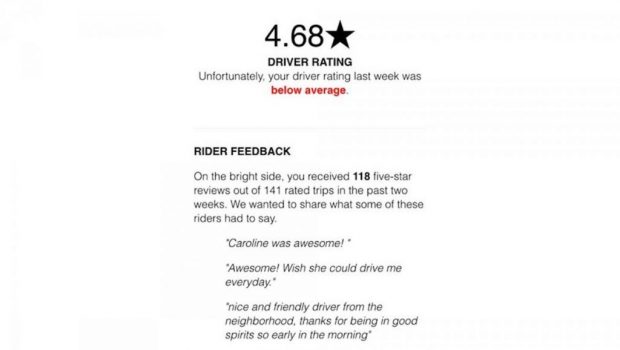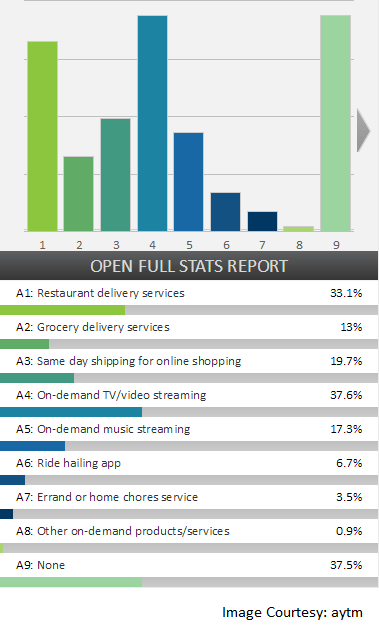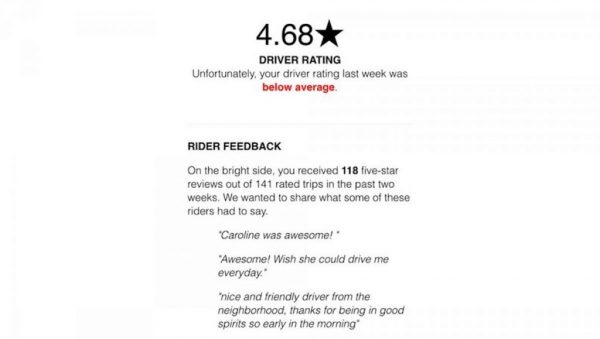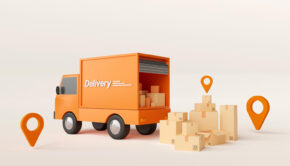8 Crucial Steps to Creating a Successful On-Demand Delivery App
On-demand delivery app is a mobile application that serves people at their doorstep once an order is placed through it. The convenience that it provides to customers has lead to its widespread popularity. On-demand apps are expected to flourish in the years to come, offering mobility to users.
The entire economy is experiencing a seismic shift. Today’s consumers don’t like to wait and demand immediate gratification and fast delivery. On-demand economy allows consumers to order anything, whenever they need it. From ordering food to getting a relaxing massage or hailing a ride, everything is easily available on smartphones. The below graph shows how on-demand delivery apps are used by consumers:
Customers prefer on-demand services because of its prompt delivery, lower prices compared to traditional sellers, convenience in ordering and payment, facility of live tracking the order, etc. In fact, the on-demand economy is attracting more than 22.4 million consumers annually and $57.6 billion in spending.
The rise of on-demand delivery apps has made many businesses plunge into the development of such app. Building an on-demand delivery app, however, doesn’t ensure its success and popularity among consumers. You need to understand the demand of your target audience and include all the requisite features in your app, for it to get accepted. Before you set out on your appreneurial journey, read on to learn more about the steps you need to follow to develop a perfect on-demand delivery app.
1. Understanding Demand
The first important step in developing an on-demand delivery app is understanding the demand of consumers and their problems. The demand should be frequent, not seasonal otherwise you might face the risk of failure. For example, Cherry, an on-demand car wash app failed because consumers probably didn’t need a car wash every day. Uber is successful because people need to move from one place to another frequently. By introducing an app that meets the dire demand of consumers or solves their problem, you have high chances of being successful.
2. Market Analysis
Analyzing the market is important as there are already several on-demand delivery apps in the market. You might want to design an app that fulfills a particular demand of the consumers, but there might be other players too.
Find out what customers think about the services provided by your competitors, what people like and don’t like about them, and what extra services they lack. You can interview your target audience and even conduct discussions on forums and social media.
The analysis of the existing on-demand services will also give you an idea of what is popular and what is hard to find.
3. Defining Target Audience
You need to define your target audience and build their personas. It is vital to know about the demographics of your users. By having an idea about your target audience, you can cater to their needs effectively.
Beginning with the local market is preferable and a profitable way of business. Uber, Airbnb, and Instacart started their business with one city. You can even identify a niche market, where you can target a specific audience and become a market leader.
4. Deciding Revenue Model
The most important consideration for building an on-demand delivery app is the revenue model. Based on the industry, you can generate revenues from customers and service providers.
You can have a commission-based revenue model, where you can take a certain percentage of commission after successful completion of the transaction. You can even earn through advertisements and featured listings.
5. Finding Service Providers
There are two sides for any on-demand app business – one is the consumer side and the other supplier. Before you start with the consumer side, you will have to find the suppliers. No matter what type of services you wish to offer, you will need service providers to cater to your customers in the entire geographic area you plan to operate in. You can look for providers that already have customers they can bring to your business. Initially, you can do cold calling and ask service providers to join by providing them attractive offers.
6. Incorporating Features
The psychology of convenience drives the market for on-demand delivery apps. These apps promise to order and deliver quickly, promising convenience to consumers. Any industry you want to cater to, your prime focus should be to offer convenience. Your on-demand app should include all the features that make it possible for your customers to track their orders, pay easily, give ratings and reviews, and communicate with you if necessary. Below are some of the must-have features of an on-demand delivery app:
Customer Side:
1. Registration/Login
The first important feature is to have registration/login page. Customers can be allowed to register after entering details like name, e-mail id, mobile number, location, username, and password. This can help you to track records of all customers and offer customized services to them.
Customers should be allowed to log in with their username and password after they register with you. You can even allow login via Facebook, Instagram, Twitter and other popular social platforms.
2. Search Function
Depending on the service you are providing, you should include search feature in your app. Customers should be able to find what they want to quickly and easily. Mobile screens are known to reduce the time consumers spend on searching for products and services. So, your focus should be to make your search function smart, which contains a wide range of search terms for every product or service.
3. Order Placement/Booking Services
Customers should be able to place online order/book the services from your app. They should be allowed to add wishful products to a cart and delete them, if necessary. After placing an order, your app should display the summary of the order before confirmation. You should even let customers cancel their orders if they want to.
4. Payment System
Inbuilt payments allow users to make a purchase from the app. As a developer, you will have to provide your customer with options to make payment through payment gateway like PayPal. Other payment options include credit card, debit card, net banking, mobile payment like Apple or Google Wallet. You can even offer cash on delivery option to consumers.
To make online payment process convenient for users, you should allow customers to save their card details. You need to take steps to ensure you are PCI compliant as long as you are accepting payment with cards.
5. Tracking
Customers like to live track when they order service online. They get a feeling of assurance and trust through it. Geolocation helps users to track where their provider is and how long will he take to arrive. By having a real-time GPS tracker, you can provide continuous updates to users at any time. Check template of delivery management dashboard to earn customer loyalty and increase profits from your app. Right delivery software should improve tracking analytics while saving development time.
6. Push Notifications
Your on-demand delivery app should have the feature of push notifications, which can make customers know about order status, delivery status, and other crucial information. For example, in a taxi app push notifications can give important details to consumers like model, color of the taxi, its number, expected time of arrival, etc.
Push notifications can even be used for marketing purpose, for notifying users about the latest promotions, offers, and updates.
7. Customer Service
You can integrate live chat or a third-party messenger into your on-demand delivery app for your team to respond to customers 24/7. Also, include your contact number for consumers to give you a call when needed. You can even include an FAQ section or a chatbot to answer their queries when your team can’t get in touch.
8. Ratings and Reviews
Ratings and reviews are vital for customers to know about the quality of services of various providers. Customers are influenced by word of mouth and reviews enable them to choose the best provider. Ask customers to leave ratings and reviews after availing services from you to create a trustable environment. Below is the rating given to an Uber driver, which shows her performance.
Other important features include wish and favorite lists, social media sharing, history of past orders, etc.
Supplier side:
Some important features your on-demand app should have for service providers are:
1. Registration/Login
This feature should be for service providers as well, to receive and manage orders of customers. Remember to include password changing and recovering option too.
2. Managing Orders
Service providers should be able to get the details of the order placed, ongoing deliveries, pickup and drop locations, etc. They have to keep a track record of all the orders/bookings that are coming from various customers.
3. Status Updates
After seeing the order, the service provider should be able to update its status to let customers know whether their orders are accepted, rejected, picked up or delivered.
4. Customer Support
In case of any change in the delivery process or scheduled delivery time, service providers should be able to notify customers through push notifications or chat. They should even be able to resolve the queries of customers through chat or phone.
7. Building an MVP
MVP stands for minimum viable product, which consists of only the important features, designed to get feedback from customers. Through minimum viable product, it becomes possible to evaluate your prospective business opportunities at a limited investment. You can know how feasible your app is, which mobile app development tools you can use and what changes you need to bring in the app.
After getting responses from users, you can bring improvements in the app. You can add additional features to make your on-demand delivery app a flagship. Once you have all the necessary features, you can deploy the application in an app store.
8. Growing and Retaining Customers
Before you launch your on-demand delivery app, you need to start promoting it in the market to make consumers aware it. Create a buzz about your upcoming app among your target audience. You can use different mediums like social media, PR platforms, inbound marketing techniques, referral programs, etc. You can even collaborate with various retailers with a customer base to advertise about your app. Instacart and Postmates had used the same strategy.
You can take the help of influencers to promote your app. People tend to listen to them and consider their recommendations. On average, businesses generate $6.50 in revenue for each $1 invested in influencer marketing.
You can attract users for once, but to retain them you need to keep them interested in your app. If you don’t want to lose your customers, you will have to provide them seamless support, giving them quick and friendly replies. You have to ensure prompt delivery services as well.
Offering users discounts, gifts, and vouchers is an effective way to keep them loyal to you. By adding rating and review system in your app, you can encourage users to rate you, which will help you in gaining more customers. 88% of consumers say they trust online reviews as much as personal recommendations.
To ensure the success of your on-demand delivery app, track users’ activities like which features are widely used and how much time they spend on your app. By understanding consumer behavior, you will be able to retain them and serve them in a better way.
Final Thoughts
On-demand delivery apps are in vogue and are here to stay for long. Developing such app, however, requires creativity, skills, knowledge, experience and a passion for technology.
Make sure your app is user-friendly, and customers can navigate easily, find what they are looking for, place and track their orders quickly and leave their feedback and share it. You can take lessons from the experience of the market leaders to get favorable results. By creating a highly-functional on-demand delivery app, not only can you reap massive benefits but also add immense value to your local economy.
About the author:

Nidhi is working as a content and brand strategist at ProDesigns – a graphic design company, recommending strategies to meet customers’ goals and deliver a superior user experience. She provides content leadership, ensuring that a consistent brand message is delivered to the audience.


















